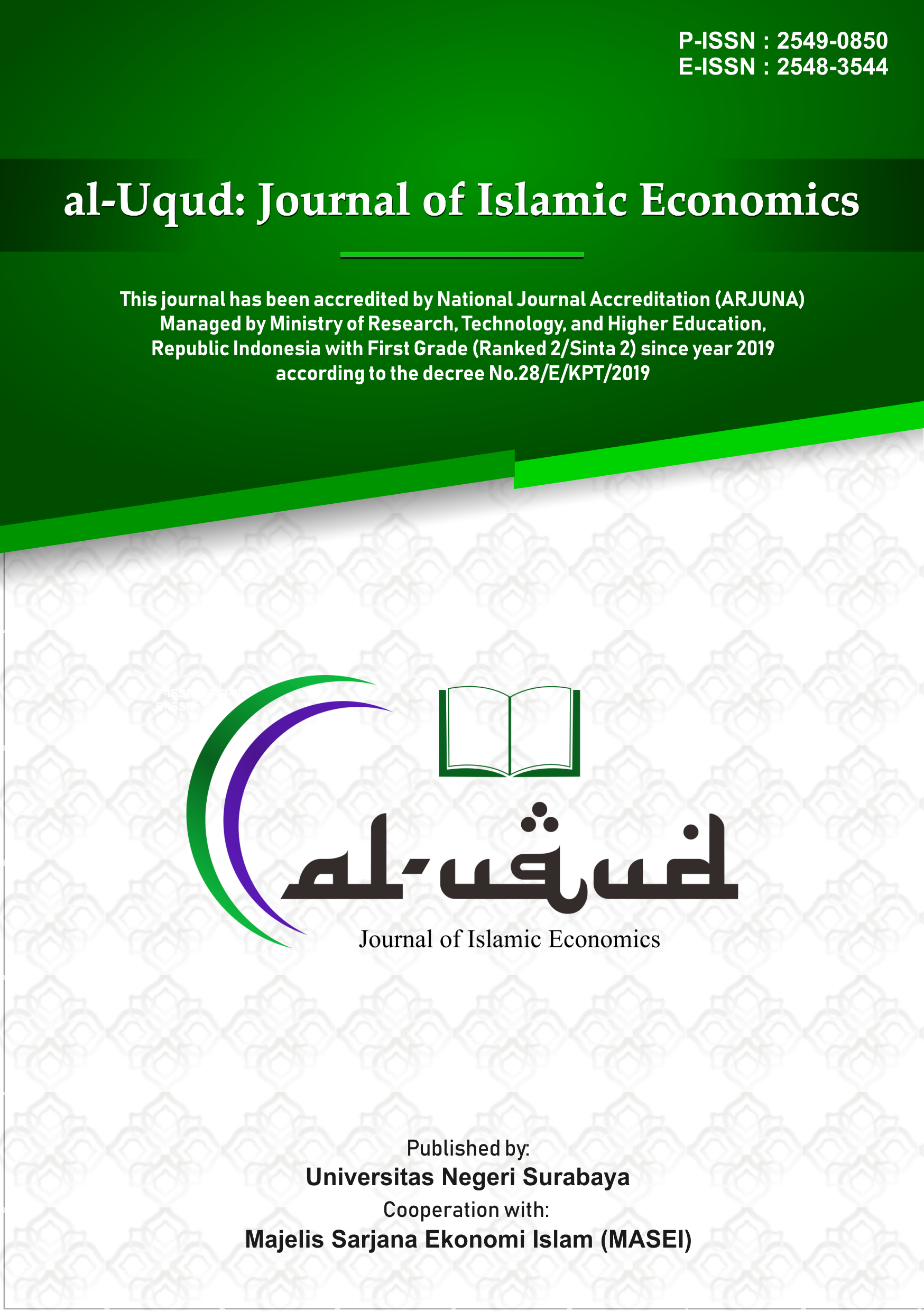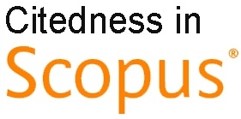TECHNICAL EFFICIENCY LEVEL OF ISLAMIC BANK IN INDONESIA
DOI:
https://doi.org/10.26740/al-uqud.v3n2.p114-132Keywords:
Efficiency, Islamic Bank, DEA, TobitAbstract
One of the common measurements used to evaluate a companys performance is the efficiency performance which indicates a companys efficiency score in utilizing inputs to produce outputs. This study aims to evaluate the performance of state-owned Indonesian Islamic banks by measuring their technical efficiency along with the determinant factors of their efficiency over the period 2014-2017. In this study, DEA, a non-parametric technique method, is employed to measure the efficiency of four state-owned Indonesia Islamic banks. Another method, Tobit-regression, is used to identify the determinant factors of their efficiency. Four state-owned Indonesian Islamic banks are chosen as the object of this study, namely Bank Syariah Mandiri, BNI Syariah , Bank Rakyat Indonesia Syariah, and BTN Syariah. The results of calculation using DEA methos show that the average efficiency level of all state-owned Indonesian Islamic banks over four consecutive yerars is 100%. It means that all the state-owned Indonesian Islamic banks operating in Indonesia have been able to optimize all their resources and are considered efficient over the period 2014-2017. Tobit-regression model results show that bank size, capitalization, and profitability significantly affect all state-owned Islamic banks efficiency, while bank expenses do not have a significant effect on their efficiency.
References
Abidin, Z., & Endri. (2009). Kinerja Efisiensi Teknis Bank Pembangunan Daerah¯: Pendekatan Data Envelopment Analysis ( DEA ). Jurnal Akuntansi Dan Keuangan, 11, 2129. Retrieved from http://jurnalakuntansi.petra.ac.id/index.php/aku/article/view/17863
Ahmad, N. H., & Mohamad Noor, M. A. (2011). The Determinants (of) Efficiency and Profitability of World Islamic Banks. International Conference on E-Business, Management and Economics.
Amirillah, A. (2014). Efisiensi Perbankan Syariah Di Indonesia. JEJAK Journal of Economics and Policy. https://doi.org/10.15294/jejak.v7i1.3596
Ardiani, N. (2019). the Efficiency of Zakat Collection and Distribution: Evidence From Data Envelopment Analysis. Al-Uqud¯: Journal of Islamic Economics, 3(1), 54. https://doi.org/10.26740/al-uqud.v3n1.p54-69
Benarda, Sumarwan, U., & Hosen, M. nadratuzzaman. (2016). Tingkat Efisiensi Industri Asuransi Jiwa Syariah Menggunakan Pendekatan Two Stage Data Envelopment Analysis. Jurnal Aplikasi Bisnis Dan Manajemen, 2(1), 6472. https://doi.org/10.17358/JABM.2.1.64
Efferin, S. (2008). Metode Penelitian Akuntansi: Mengungkap Fenomena dengan pendekatan Kuantitatif dan Kualitatif. Yogyakarta: GRAHA ILMU.
Fachrudin, K. A. (2011). Analisis Pengaruh Struktur Modal, Ukuran Perusahaan, dan Agency Cost Terhadap Kinerja Perusahaan. Jurnal Akuntansi Dan Keuangan. https://doi.org/10.9744/jak.13.1.37-46
Fathony, M. (2012). Estimasi Dan Faktor-Faktor Yang Memengaruhi Efisiensi Bank Domestik Dan Asing Di Indonesia. Jurnal Keuangan Dan Perbankan.
Firdaus, M. faza, & Hosen, M. N. (2014). Efisiensi Bank Umum Syariah Menggunakan Pendekatan Two-Stage Data Envelopment Analysis. Buletin Ekonomi Moneter Dan Perbankan. https://doi.org/10.21098/bemp.v16i2.31
Harjum Muharam, & Pusvitasari, R. (2007). Analisis Perbandingan Efisiensi Bank Syariah di Indonesia Dengan Metode Data Envelopment Analysis (periode Tahun 2005). Fakultas Ekonomi Universitas Diponegoro Semarang.
Hartomo, Deny Dwi, W. D. E. (2018). Efisiensikah Bank Umum Syariah di Indonesia. Jurnal Bisnis & Manajemen, 18(1), 5367.
Huang, S. G. H., & Song, F. M. (2002). The Determinants of Capital Structure: Evidence from China. SSRN Electronic Journal. https://doi.org/10.2139/ssrn.320088
Idhat, D. G. (2015). Ini 7 Masalah Bank Syariah. Retrieved October 23, 2018, from https://m.tempo.co/read/news/2015/11/22/087721104/ini7-masalah-bank-syariah
Ismail, F., Shabri Abd. Majid, M., & Rahim, R. A. (2013). Efficiency of Islamic and conventional banks in Malaysia. Journal of Financial Reporting and Accounting. https://doi.org/10.1108/JFRA-03-2013-0011
Kasmir. (2012). Analisis Laporan Keuangan. Jakarta: PT. Rajagrafindo Persada.
Laroche, M., Babin, B. J., Lee, Y. K., Kim, E. J., & Griffin, M. (2005). Modeling consumer satisfaction and word-of-mouth: restaurant patronage in Korea. Journal of Services Marketing. https://doi.org/10.1108/08876040510596803
Masyrafina, I. (2017). Pangsa Pasar Perbankan Syariah Harus 15 Persen Agar Efisien. Retrieved October 23, 2018, from https://www.republika.co.id/berita/ekonomi/syariah-ekonomi/owxrlp368/tradisi-ramadhan
Mokhtar, H. S. A., Abdullah, N., & Alhabshi, S. M. (2008). Efficiency and competition of Islamic banking in Malaysia. Humanomics. https://doi.org/10.1108/08288660810851450
Muhamad Azhari Wahid. (2016). Comparing the Efficiency of Islamic and Conventional Banks Based on the Evidence from Malaysia. Journal of Muamalat and Islamic Finance Research.
Mustainah, H., Saifi, M., & NP, M. W. E. (2017). Analisis Perbandingan Tingkat Efisiensi Bank Umum Swasta Nasional dan Bank Asing di Indonesia Berdasarkan Data Envelopment Analysis. Jurnal Administrasi Bisnis, 44(1), 2430.
Nguyen, T. L. A. (2018). Diversification and bank efficiency in six ASEAN countries. Global Finance Journal. https://doi.org/10.1016/j.gfj.2018.04.004
Nurkholis, & Purwanto, A. (2015). Analisis Faktor-faktor yang Mempengaruhi Kebijakan Dividen (Studi Empiris Pada Perusahaan Manufaktur yang Terdaftar di BEI Periode 2010-2013). Diponegoro Journal of Accounting, 4(2), 211220.
Otoritas Jasa Keuangan. (2017). Indonesia Banking Statistics. Retrieved from https://www.ojk.go.id/
Permana, F. Y., & Adityawarman. (2015). Analisis Faktor-Faktor yang Mempengaruhi Tingkat Efisiensi Perankan Syariah di Indonesia. Diponegoro Journal of Accounting, 4, 114. Retrieved from http://ejournal-s1.undip.ac.id/index.php/accounting
Pohan, A. A. (2015). Efisiensi Kinerja Bank Umum Syariah dan Bank Pembiayaan Rakyat Syariah di Indonesia. Institut Pertanian Bogor.
Řepková, I. (2014). Efficiency of the Czech Banking Sector Employing the DEA Window Analysis Approach. Procedia Economics and Finance. https://doi.org/10.1016/S2212-5671(14)00383-9
Sambasivam, Y., & Ayele, A. G. (2013). A Study On The Performance Of Insurance Companies In Ethiopia. International Journal of Marketing, Financial Services & Management Research.
Siudek, T. (2008). Theoretical Foundations of Banks Efficiency and Empirical Evidence from Poland. Social Research, 3(13), 150158.
Sufian, F., Kamarudin, F., & Noor, N. H. H. M. (2012). Determinants of revenue efficiency in the Malaysian Islamic banking sector. Journal of King Abdulaziz University, Islamic Economics. https://doi.org/10.4197/Islec.25-2.7
Sugiyono. (2010). Metode Penelitian Pendidikan Pendekatan Kuantitatif, Kualitatif dan R&D. Bandung: Alfabeta.
Talebnia, G., Valipour, H., & Shafiee, S. (2010). Empirical Study of the Relationship between Ownership Structure and Firm Performance¯: Some Evidence of Listed Companies in Tehran Stock Exchange. Journal of Sutainable Develeopment.
Tanjung, H., & Devi, A. (2013). Metode Penelitian Ekonomi Islam. Jakarta: Gramata Publishing.
Zamil, Nor Aiza Mohd., A. R. A. R. (2006). Efficiency of Sharia and Conventional Commercial Banks in Malaysia: A Data Envelopment Analysis (DEA) Study.
Downloads
Published
How to Cite
Issue
Section
License
CC BY 4.0 Abstract views: 924
,
Abstract views: 924
, PDF Downloads: 697
PDF Downloads: 697








